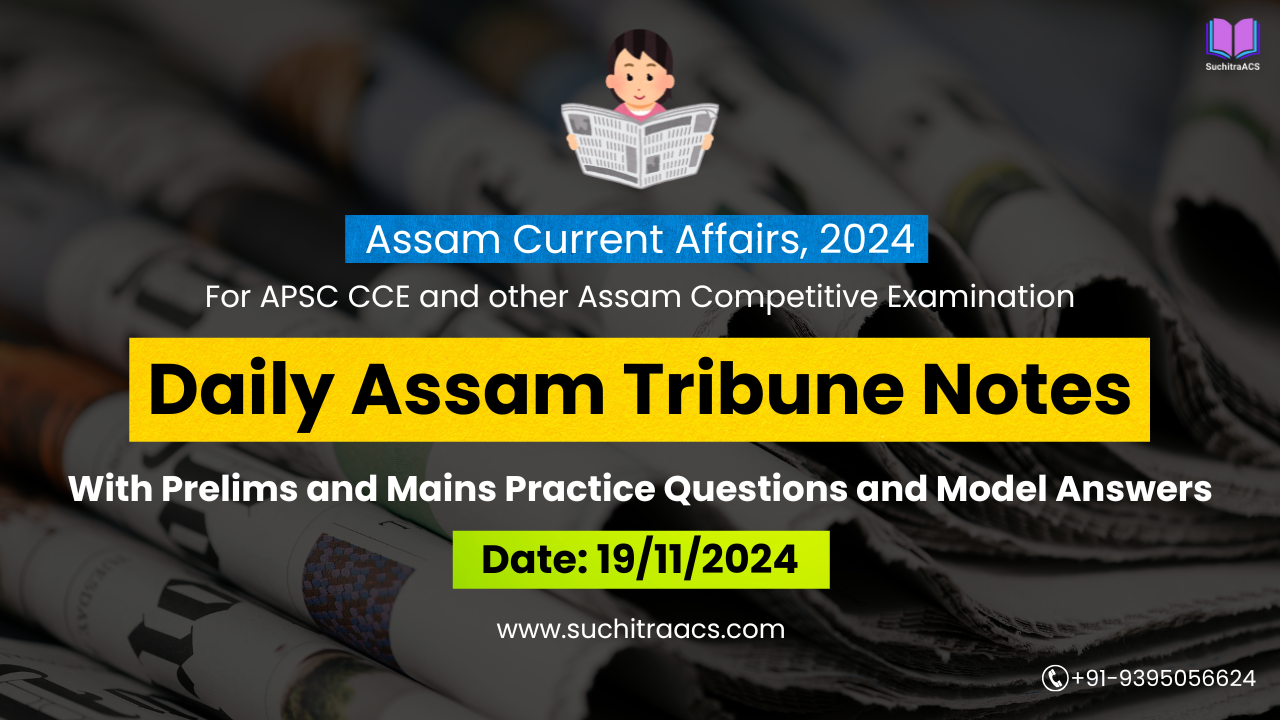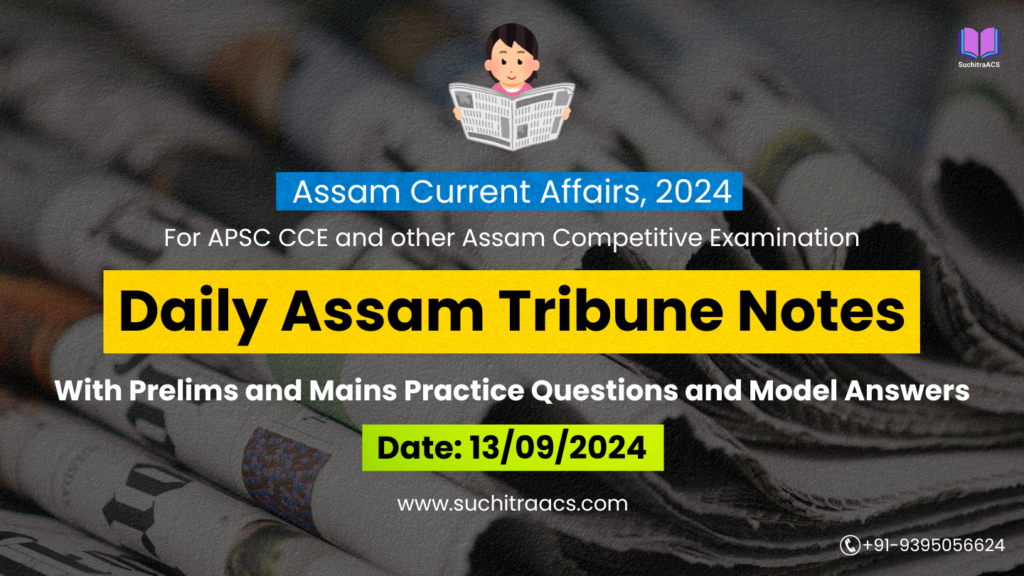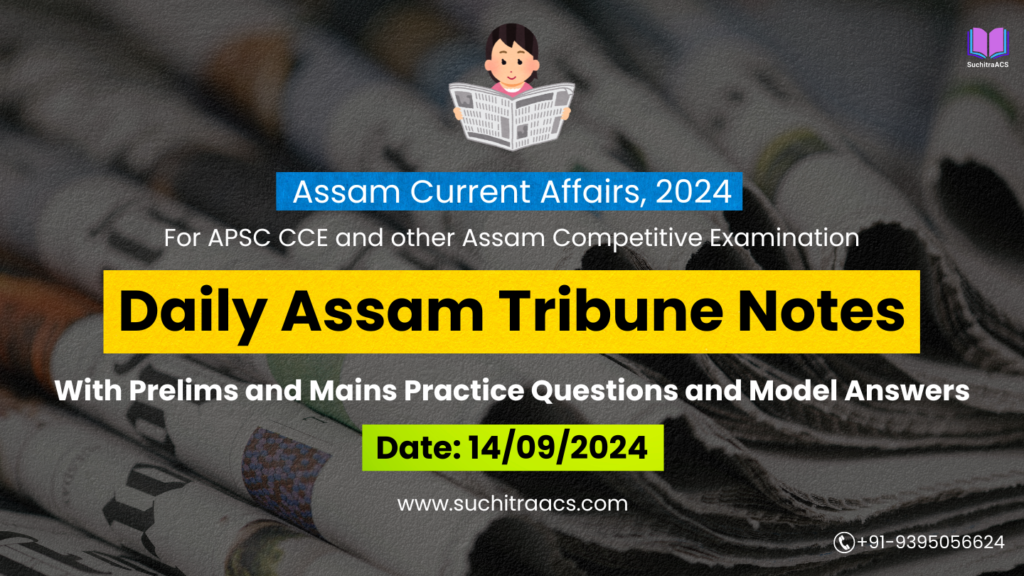APSC Current Affairs: Assam Tribune Notes with MCQs and Answer Writing (19/11/2024)
For APSC CCE and other Assam Competitive examinations aspirants, staying updated with current affairs is vital. This blog covers most important topics from the Assam Tribune today (19-11-2024). These issues are key for both APSC Prelims and Mains preparation, offering insights into the APSC CCE Syllabus.
Topic 1: India’s Maritime Sector Vision 2047
GS Paper 3: Economy, Infrastructure Development
Introduction:
India aims to revolutionize its maritime sector by 2047 with an investment of ₹80 lakh crore. This initiative targets enhanced port capacity, sustainable shipping, and inland waterway development, positioning India as a global maritime leader.
Key Points:
- Development of mega ports at Vizhinjam (Kerala) and Vadhavan (Maharashtra).
- Reviving shipbuilding legacy with clean-fuel ships (ammonia, hydrogen, electricity).
- Targeting a port handling capacity of 10,000 MMT per annum.
- Strategic focus on trade routes like the India-Middle East-Europe Economic Corridor.
Prelims Pointers:
- Vizhinjam Port: A deep-water international seaport under construction in Kerala.
- Green Ships: Vessels using clean fuels such as ammonia and hydrogen.
Mains Pointers:
- Importance:
- Boosts economic growth through trade and job creation.
- Enhances regional connectivity and global trade links.
- Promotes sustainability with green technology adoption.
- Positions India as a significant player in the global maritime industry.
- Advances inland water transport, reducing logistic costs.
- Challenges:
- High initial investment requirements.
- Environmental concerns over mega port projects.
- Ensuring global competitiveness in shipbuilding.
- Balancing local community interests with development goals.
- Regulatory bottlenecks slowing project approvals.
- Way Ahead:
- Implement robust public-private partnerships (PPP) for funding.
- Promote eco-friendly practices in port and shipbuilding projects.
- Strengthen maritime skill development and R&D.
- Fast-track regulatory approvals for projects.
- Develop global partnerships for advanced technologies.
Conclusion:
India’s maritime sector vision is an ambitious step toward economic self-reliance and global leadership. Sustainable policies and strategic partnerships are crucial to achieving this goal.
Topic 2: Assam Police on High Alert Against Manipur Violence Spillover
GS Paper 3: Internal Security, Governance
Introduction:
With escalating violence in Manipur, Assam Police has intensified measures to prevent spillover into the state. The volatile situation demands enhanced security and coordination across the Northeast.
Key Points:
- Additional forces deployed along the Assam-Manipur border.
- Police thwarted attempts to incite tensions through rallies and processions.
- Enhanced vigilance on new entrants in border areas.
Prelims Pointers:
- Manipur Violence: Ongoing ethnic conflict between Meitei and Kuki communities.
- Assam Police: State’s law enforcement body maintaining public safety.
Mains Pointers:
- Importance:
- Maintains peace and stability in Assam.
- Prevents spillover effects of ethnic conflicts.
- Ensures public confidence in governance.
- Protects Assam’s socio-economic environment.
- Strengthens regional cooperation for security.
- Challenges:
- Porous borders complicate monitoring efforts.
- Difficulty in identifying potential troublemakers.
- Balancing security with local sensitivities.
- High resource demands for prolonged operations.
- Coordination issues between Assam and Manipur authorities.
- Way Ahead:
- Enhance border surveillance with advanced technologies like drones.
- Foster inter-state cooperation for intelligence sharing.
- Conduct community outreach programs to build trust.
- Strengthen infrastructure in sensitive border regions.
- Provide adequate resources to law enforcement agencies.
Conclusion:
Proactive measures by Assam Police are critical to containing the spillover of violence from Manipur. A coordinated, long-term approach is essential for ensuring peace in the region.
Topic 3: Urban Heat Island Effect in Guwahati
GS Paper 1: Geography
GS Paper 3: Environment
Introduction:
Urban Heat Island (UHI) effect is becoming a significant issue in Guwahati, driven by rapid urbanization, reduced green cover, and increased construction activities. The phenomenon refers to higher temperatures in urban areas compared to their rural surroundings.
Key Points:
- UHI in Guwahati has been exacerbated by deforestation and concretization.
- The average temperature in urban areas is significantly higher than in neighboring rural regions.
- Poor urban planning and lack of green spaces are critical contributors to the rising temperatures.
Prelims Pointers:
- Urban Heat Island (UHI): An urban area significantly warmer than its surrounding rural areas due to human activities.
- Key Contributors: Reduced vegetation, increased construction, and high energy consumption.
Mains Pointers:
- Importance:
- Highlights the need for sustainable urban planning.
- Affects the health and well-being of urban residents.
- Increases energy demand for cooling systems.
- Impacts biodiversity and local ecosystems.
- Encourages investment in green technologies.
- Challenges:
- Lack of urban forests and green cover.
- Insufficient public awareness about sustainable practices.
- High cost of green infrastructure projects.
- Poor enforcement of environmental regulations.
- Unchecked construction activities.
- Way Ahead:
- Promote afforestation and urban forestry.
- Incorporate green roofs and reflective building materials.
- Develop policies for sustainable urban planning.
- Conduct awareness campaigns for reducing energy consumption.
- Implement strict regulations on land-use planning and construction.
Conclusion:
Tackling the Urban Heat Island effect in Guwahati requires a holistic approach combining sustainable planning, green infrastructure, and community participation.
Topic 4: Launch of the Kho Kho World Cup
GS Paper 2: Governance, Sports and Culture
Introduction:
India is set to host the first-ever Kho Kho World Cup in January 2025, marking a significant step in promoting indigenous sports on a global platform. Organized by the Kho Kho Federation of India in collaboration with the Indian Olympic Association (IOA), the event aims to elevate the status of Kho Kho internationally.
Key Points:
- The event will be hosted at the Indira Gandhi Indoor Stadium, Delhi.
- IOA President PT Usha emphasized the cultural significance of Kho Kho.
- Over 20 countries are expected to participate in the tournament.
Prelims Pointers:
- Kho Kho: A traditional Indian tag game, emphasizing speed and agility.
- Indian Olympic Association (IOA): Governs Olympic sports in India.
Mains Pointers:
- Importance:
- Promotes traditional sports at an international level.
- Encourages global recognition of India’s cultural heritage.
- Boosts local economies through tourism and sponsorships.
- Inspires youth participation in indigenous sports.
- Enhances India’s soft power in international diplomacy.
- Challenges:
- Limited infrastructure for indigenous sports.
- Inadequate funding and sponsorship opportunities.
- Low awareness of Kho Kho among the global audience.
- Coordination challenges between stakeholders.
- Balancing traditional rules with global sports regulations.
- Way Ahead:
- Develop state-of-the-art infrastructure for Kho Kho.
- Promote the sport through international media coverage.
- Engage private sponsors to fund the tournament.
- Conduct training programs for referees and players.
- Leverage digital platforms to popularize Kho Kho globally.
Conclusion:
The Kho Kho World Cup represents a unique opportunity to globalize an indigenous sport, preserving cultural heritage while fostering international camaraderie.
APSC Prelims Practice Questions
Topic 1: India’s Maritime Sector Vision 2047
Question 1: With reference to India’s Maritime Sector Vision 2047, consider the following statements:
- Vizhinjam Port in Kerala is being developed as a deep-water international seaport.
- India aims to achieve a port handling capacity of 10,000 MMT per annum by 2047.
- The initiative includes the construction of green ships using fossil fuels like diesel and LNG.
Which of the statements given above is/are correct?
A. 1 and 2 only
B. 1 and 3 only
C. 2 and 3 only
D. 1, 2, and 3
Answer: A. 1 and 2 only
Explanation:
- Statement 1 is correct. Vizhinjam Port is being developed as a deep-water international seaport in Kerala.
- Statement 2 is correct. India’s Vision 2047 targets a port handling capacity of 10,000 MMT annually.
- Statement 3 is incorrect. Green ships are designed to use clean fuels like ammonia and hydrogen, not traditional fossil fuels.
Topic 2: Assam Police on High Alert Against Manipur Violence Spillover
Question 2: With reference to the Assam Police and internal security, consider the following statements:
- The Assam Police is responsible for law enforcement and maintaining public safety within the state.
- The ongoing ethnic conflict between the Meitei and Kuki communities in Manipur has led to increased security measures in Assam.
- The Assam-Manipur border is demarcated under the Sixth Schedule of the Indian Constitution.
Which of the statements given above is/are correct?
A. 1 and 2 only
B. 2 and 3 only
C. 1 and 3 only
D. 1, 2, and 3
Answer: A. 1 and 2 only
Explanation:
- Statement 1 is correct. Assam Police is the primary agency for maintaining law and order in the state.
- Statement 2 is correct. Ethnic violence in Manipur has led to enhanced security measures along the Assam-Manipur border.
- Statement 3 is incorrect. The Sixth Schedule pertains to the administration of tribal areas, not border demarcation.
Topic 3: Urban Heat Island Effect in Guwahati
Question 3: Consider the following about the Urban Heat Island (UHI) effect:
- UHI refers to higher temperatures in urban areas compared to their surrounding rural areas.
- Increased green cover and reflective building materials can help mitigate the UHI effect.
- Guwahati has experienced a decline in the UHI effect due to urban afforestation initiatives.
Which of the statements given above is/are correct?
A. 1 and 2 only
B. 1 and 3 only
C. 2 and 3 only
D. 1, 2, and 3
Answer: A. 1 and 2 only
Explanation:
- Statement 1 is correct. The Urban Heat Island effect results in higher temperatures in urban areas due to human activities.
- Statement 2 is correct. Green cover and reflective materials reduce heat absorption, mitigating UHI effects.
- Statement 3 is incorrect. Guwahati continues to face rising UHI due to deforestation and unchecked construction.
Topic 4: Launch of the Kho Kho World Cup
Question 4: With reference to the Kho Kho World Cup, consider the following statements:
- Kho Kho is a traditional Indian tag game emphasizing speed and agility.
- The first Kho Kho World Cup will be hosted in Ahmedabad, Gujarat.
- Over 20 countries are expected to participate in the tournament.
Which of the statements given above is/are correct?
A. 1 only
B. 1 and 3 only
C. 2 and 3 only
D. 1, 2, and 3
Answer: B. 1 and 3 only
Explanation:
Statement 3 is correct. The tournament is expected to feature participation from over 20 countries.
Statement 1 is correct. Kho Kho is a traditional Indian game known for speed and agility.
Statement 2 is incorrect. The first Kho Kho World Cup will be hosted at the Indira Gandhi Indoor Stadium, Delhi.
APSC Mains Practice Question
Question:
Ethnic conflicts in one state often have spillover effects in neighboring regions, posing challenges to internal security and governance. Examine the role of law enforcement in preventing such spillovers, using the Assam-Manipur situation as a case study. Discuss strategies to address these challenges while ensuring peace and stability.
Model Answer
Introduction:
Ethnic conflicts in one region often ripple into neighboring areas, as seen with the ongoing violence in Manipur, which has raised internal security concerns in Assam. Such spillovers challenge governance, disrupt social harmony, and strain law enforcement. Effective measures are crucial to maintain peace and stability while addressing the root causes of conflicts.
Role of Law Enforcement in Preventing Spillovers:
- Border Surveillance:
Assam Police has intensified patrols along the Assam-Manipur border to monitor cross-border movements and prevent illegal entry of miscreants. - Intelligence Gathering:
Collecting actionable intelligence on potential unrest or inflammatory activities is key to preempting violence. - Community Policing:
Building trust through regular interaction with communities helps law enforcement address local grievances and mitigate tensions. - Neutralizing Misinformation:
Assam Police has countered attempts to incite tensions by monitoring social media and curbing the spread of inflammatory content. - Collaboration with Manipur Authorities:
Coordination between Assam and Manipur law enforcement agencies ensures effective response to cross-border threats.
Challenges in Addressing Spillovers:
- Porous Borders: Difficult terrain complicates monitoring efforts, allowing miscreants to cross undetected.
- Resource Constraints: Prolonged operations require significant manpower and funding.
- Inter-Community Tensions: Historical mistrust between ethnic groups hinders reconciliation.
- Spread of Misinformation: Social media amplifies rumors, fueling tensions.
- Coordination Issues: Differences in priorities between states delay unified action.
Strategies to Ensure Peace and Stability:
- Technological Integration:
Use drones, surveillance cameras, and AI tools to monitor border areas effectively. - Enhanced Intelligence Sharing:
Establish inter-state mechanisms for real-time exchange of intelligence. - Stakeholder Engagement:
Conduct dialogues involving community leaders, civil society, and local administrations to foster trust and address grievances. - Crisis Management Teams:
Deploy specialized rapid-response units trained in conflict de-escalation and riot control. - Strengthening Socioeconomic Development:
Address underlying causes of conflict by improving infrastructure, education, and employment opportunities in affected areas.
Conclusion:
The Assam-Manipur situation highlights the critical role of law enforcement in maintaining internal security amidst ethnic conflicts. A proactive and collaborative approach, supported by technological advancements and community engagement, can effectively mitigate spillover effects and ensure peace and stability in the region.
✨ APSC Prelims Crash Course, 2025
at most affordable rate in Assam!

🔔 Join Our WhatsApp Study Group!
For exclusive access to premium quality content, including study materials, current affairs, MCQs, and model answers for APSC CCE and other Assam competitive exams.
Click here to join: SuchitraACS Study WhatsApp Group
📚 Want to know more about SuchitraACS’s most affordable courses?
Click here to know more: SuchitraACS Courses for APSC CCE and Assam Competitive Examinations




